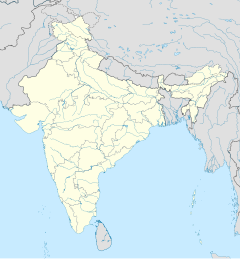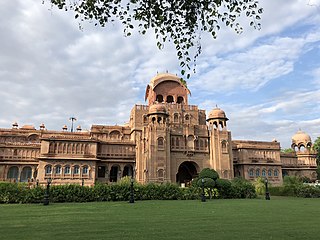
Bikaner is a city in the northwest of the state of Rajasthan, India. It is located 330 kilometres (205 mi) northwest of the state capital, Jaipur. Bikaner city is the administrative headquarters of Bikaner District and Bikaner division.

The Bishnoi Panth, also spelled as Vishnoi Panth, is a Hindu Vaishnava Sampradaya or Panth found in the Western Thar Desert and northern states of India. It has a set of 29 Niyamas (principles/commandments) given by Guru Jambheshwar (1451–1536). As of 2010, there are an estimated 600,000 followers of Bishnoi Panth residing in northern and central India. Shree Guru Jambheshwar founded the sect at Samrathal Dhora in 1485 and his teachings, comprising 120 shabads, are known as Shabadwani. He preached for the next 51 years, travelling across India. The preaching of Guru Jambhoji inspires his followers as well as environmental protectors. The Bishnoi sect admitted members from a variety of communities including Jats, Banias, Charans, Rajputs, and Brahmins.
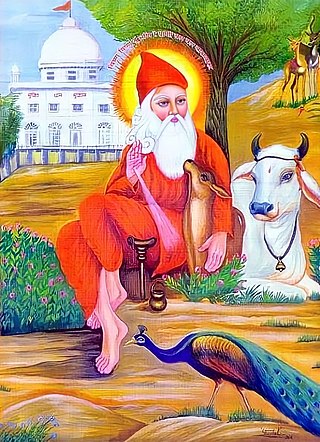
Guru Jambheshwar, also known as Guru Jambhoji, (1451–1536) was the founder of the Bishnoi Panth, a Hindu subsect of Vaishnavism.

Bhind district is a district in the Chambal division of the Indian state of Madhya Pradesh.
Rameshwar Lal Dudi is an Indian politician, farmer leader from Bikaner, Rajasthan. He served as the Leader of the Opposition (LoP) in Rajasthan Legislative Assembly. He served as the Member of Parliament, Lok Sabha from Bikaner from 1999 to 2004, but he lost the seat to Dharmendra Deol in 2004. He is a member of the Indian National Congress.

Moti Dungri is a Hindu temple complex dedicated to Lord Ganesha in Jaipur, Rajasthan. It was built in 1761 under supervision of Seth Jai Ram Paliwal. The temple is a popular tourist attraction in the city and is located next to the Birla Temple.

Mukam is a village, and most sacred site of Mukam Mukti Dham temple of Bishnoi community, located on Bikaner-Jodhpur State Highway 20 about 10 mi (16.09 km) from Nokha and 40 mi (64.37 km) from Bikaner in Bikaner district in the Indian state of Rajasthan.

The Sikri Mata Temple, officially known as the Shri Mahamaya Devi Temple, is a Hindu temple at Sikri Khurd village, Ghaziabad district, Uttar Pradesh, India. The temple was built in the 17th century by Jalim Giri Baba and his family, who belonged to the Goswami community of the village. Its administration was taken over from the descendants of Giri Baba by the gram panchayat in 1977. Dedicated to the goddess Sikri, who is believed to be an incarnation of Durga, the temple attracts large gatherings of visitors during the biannual festival of Navaratri. During the Chaitra month of Navaratri, marking the beginning of a new year on the Hindu calendar, a large historical fair is organised for nine days. The fair was cancelled in 2020 due to the COVID-19 pandemic for the first time since 1918. There is a banyan tree on the temple premises from which more than 130 revolutionaries were hanged to death during the Indian Rebellion of 1857.

Krishnadas Payahari, also known as Payahari Baba was a Ramanandi Hindu saint and disciple of Anantananda, one of the twelve disciple of Ramananda. Krishnadas Payohari was the founder and first Mahant of Gaddi of Galtaji dham, Jaipur. He came to Galta early in the 16th century. He was the guru of Prithvi Singh, ruler of Amber (Jaipur) and his wife Apurva Devi. He was also guru of Raja Jagat Singh of Kullu.

Ghushmeshwar is a Shiva temple, claimed by devotees to be the twelfth Jyotirlinga of Lord Shiva in the Hindu religion, which is located in the village of Shiwar, Rajasthan, India.
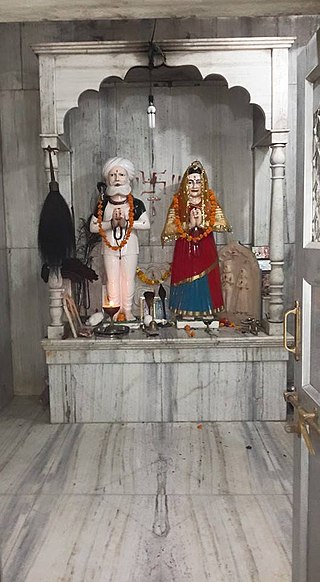
Khema Baba Temple is a Hindu temple dedicated to folk deity, Lord Sidh Shree Khema Baba located near a sand dune, in Baytu, Barmer District of Rajasthan at Latitude 25.89201°N and Longitude 71.77074°E. It is 48 km (30 mi) from Barmer District. It is situated at a distance of 800m from Railway station and Govt bus stand Baytu.
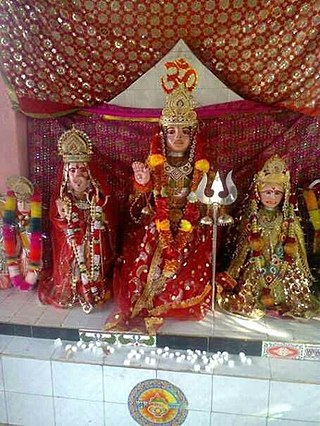
Dhabbawali Mata Temple is a famous Hindu temple located in the Sanchore district of Rajasthan, India. The idol of Goddess Dhabbawali Mata is installed in it. It is situated at Khasarvi, 35km north-west of District Sanchore. A Goddess Peeth on the revered land of Rajasthan, which is situated on the holy land of village Khasarvi of district Sanchore.
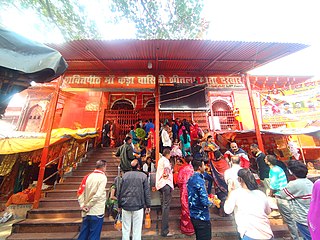
Sheetla Devi Temple is a Hindu temple dedicated to the mother goddess Shitala, located in Kara, Uttar Pradesh. It is one of the 51 Shakti Peethas in Shaktism denomination of Hinduism. The deity of the temple is regarded as the Kuldevi of gurgaon.
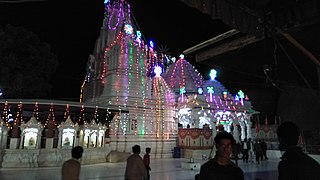
Viratra Vankal Mata Temple a 900-year-old temple of Mother goddess Vankal situated on a hilltop called Viratra, located in Barmer of Rajasthan.
Chauth Mata Temple is a Hindu temple located at a distance of about 5 kilometers from Bundi district headquarters in Rajasthan, India. The temple is dedicated to Chauth Mata, a manifestation of Hindu Goddess Parvati.
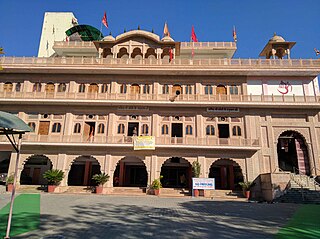
Khole Ke Hanuman Ji Temple is a Hindu temple located at a distance of about 9 km from district headquarters of Jaipur, the capital of Rajasthan state in India. The temple is dedicated to a major Hindu deity Hanuman. Apart from the devotees, domestic and foreign tourists also come here to admire the picturesque beauty of nature at this place.
Sushila Rameshwar Dudi is an Indian politician. She was elected to the 16th Rajasthan Legislative Assembly from Nokha, Bikaner. She is a member of the Indian National Congress. She is wife of Rameshwar Lal Dudi, former LoP in Rajasthan Assembly.
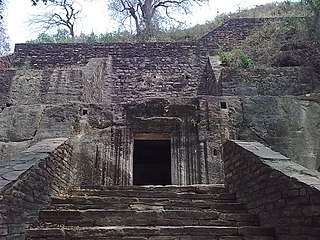
Bateshwar Sthan is an ancient site related to the Vedic sage Brahmarshi Vashishtha at Kahalgaon in Bhagalpur district of Bihar, India. It is believed as the Taposthali of the sage Vashishtha where he established Shivlinga known as Bateshwar Nath Mahadeva.
Pipasar is a village in the Nagaur district of Rajasthan, India.
Mithilapuri Jain Teerth is a sacred place in the tradition of Jainism. It is believed to be the birthplace and the penance place of the two Jain Tirthankars Bhagwan Mallinath Swami and Bhagwan Naminath Swami. According to the Digambara sect of Jainism, it is located at the Sursand town of Sitamarhi district in the Mithila region of Bihar. It is very close to the line of the Indo-Nepal International Border at the outskirts of the Sursand town. Similarly for the Śvetāmbara sect of Jainism, it is believed to be located at Dumra suburb in the city of Sitamarhi in the Mithila region.


